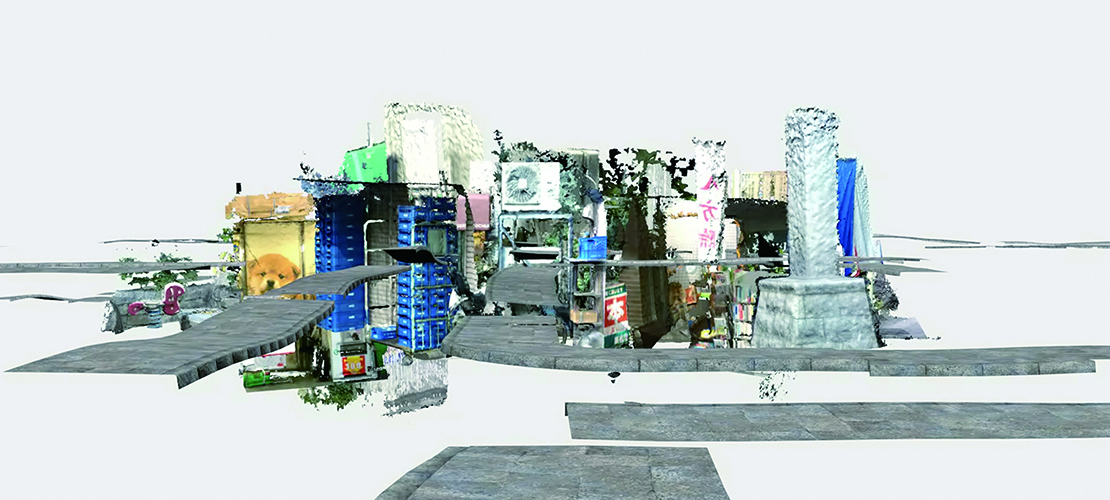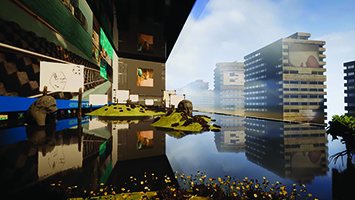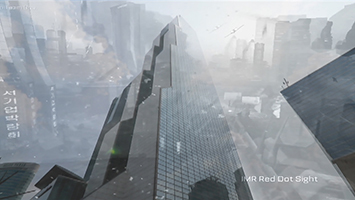

阿佐谷-軍艦島移動計畫
Gunkanjima (Nagasaki) Transfering Project
2017,單頻錄像,13分55秒
Single-channel video, 13'55"
楊秦華
YANG Qin-Hua
中國 1992年生於中國上海,現於日本東京生活及工作
China 1992 born in Shanghai China, now living and working in Tokyo, Japan
《阿佐谷-軍艦島移動計畫》為中國藝術家楊秦華的單頻道錄像作品。作品背景座落於日本 長崎的端島,又稱軍艦島。從 19 世紀初期作為煤礦產地一度成為人口密度超越當時東京人口密 度九倍的島嶼,再至 20 世紀中期煤礦業衰弱而廢島。2009 年,軍艦島被當地政府開發為觀光 景點,開始了名為「軍艦島 TOUR」的觀光行程,內容包含著海上郵輪、紀念品販賣的廢墟遺 址旅遊套餐項目。軍艦島雖是一段歷史,但它不是過去,而是一段被快進化的未來剪影。
而在谷歌地球中,這段已經被產品化了的歷史,則成為了更加具有娛樂性的圖像。在此 件作品中,藝術家將自己真實生活的街道利用 3D 掃描軟件製成模型,以實現真實生活於計算機內部的一次大型移轉與削除。軍艦島作為一則快速的生產導致快速的消亡的現實預言,在此作中成為了一處日常生活的終點。與此同時,如果將影像中谷歌地球那樣具有曖昧的失真感的視覺語言的產生原因歸結為「細節的丟失」,那進入這個世界則意味著必須要丟棄細節(或者說,作為細節的真實),並以此塑成一個更有效的世界觀。細節的丟失意味著輕量,輕量則意味著它將需要比「真實」更小的內存空間,這在未來世界無疑可被看作為一種生存策略。而現實的輕量化,終點則是一種趨於扁平的立體,是物體失去功能體積的懸置。此件作 中漂浮的街道以及被作為商品被消費的軍艦島正也明白的映照著這一機制。
Gunkanjima (Nagasaki) Transfering Project is a single-channel video work by Chinese artist Yang Qin-Hua. The background of the work is set in Hashima, also known as Gunkanjima. As the coal production base in the early 19th century, it was once an island with a population density 9 times of that in Tokyo, before the island was deserted due to the decline of coal-mining industry in the mid-20th century. In 2009, Gunkanjima was developed as a tourist destination by the local government, launching a tourist trip called “Gunkanjima Tour”, including stops such as sea cruise, souvenir sale, and a tour into the ruins. Although Gunkanjima is a history, it is not of the past. Rather, it is a fast-forwarded sketch of the future.
On Google Earth, this commercialized history becomes an even more enter- taining image. In this artwork, the artist transformed the real streets he walks on into a model with 3D scanning software, so as to realize a massive transfer and elimination of real life on the computer. As a realistic prophecy of fast produc- tion leading to fast die-out, Gunkanjima becomes the end point of daily life in this work. Meanwhile, if we attribute the ambiguous, distorted visual language of Google Earth to “the loss of detail”, to enter this world means to discard details (i.e. the reality as detail) and thus shape a more effective world view. The loss of detail means lightweight, and lightweight means it needs a smaller storage space compared to “the reality”, which will no doubt be seen as a survival strategy in the future world. The lightweight for reality is a attened cube in the end, a sus- pension after an object loses functional volume. The oating streets and the com- mercialized Gunkanjima in this work are the vivid re ection of such mechanism.







